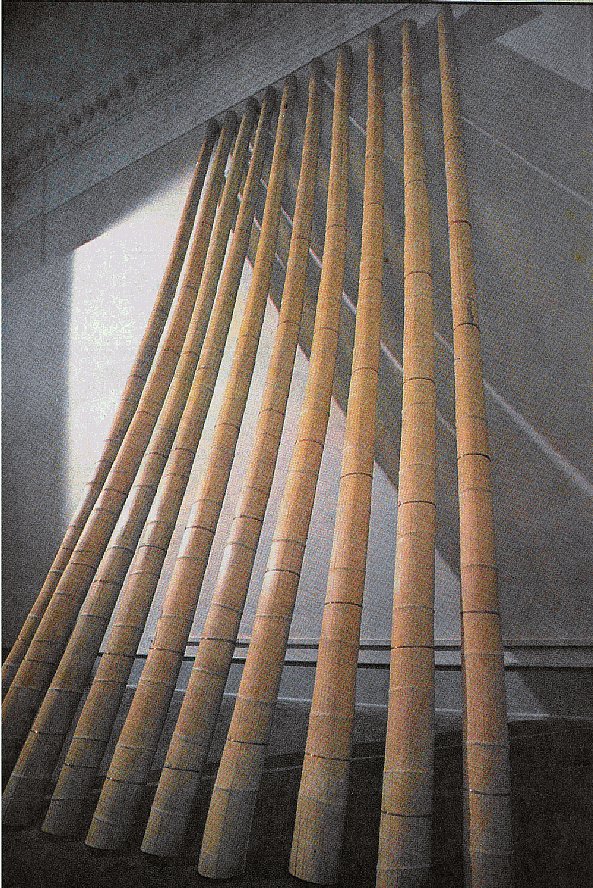| Japanese
artist works with wood, paper, silk By Alice B. Thomas(Features copy editor), Alexandria Daily Town Talk March 2, 1990 |
 |
| David Texada - Staff photographer gBamboo No.2Dh is the title of bamboo and copper sculpture by Kazuo Kadonag. |
It is a leafless, branchless place. And it is bugless, though it wouldn't be surprising to see wasps zeroing in on the oddly-natural and geometric formations of hand-made paper suspended on the walls.
Eyes closed, a visitor could easily visualize the striated patterning of hand-raked sand and the water-smoothed pebbles of a Japanese garden. A vivid imagination might allow that viewer to be lulled by remembered sounds of running streams.
There are melodies sounds, but they are coming from the soft voices of Kazuo Kadonaga and his wife Yumiko.
Kadonaga is the artist whose works give this garden ambiance. And Kadonaga does not speak English. His ideas, therefore, were first presented in pause-less rapid Japanese that sounded as if a gKh were in every other syllable. His words were re-phrased in English by his wife.
gIt is not easy,h Mrs. Kadonaga said, glancing at her husband, then adding, gEach time, he changes his words.h She quietly laughed, the sound making Kadonaga direct a questioning look his wife's way. Then, hearing her comment in Japanese, he agreed by smiling.
Kadonagafs collarless and open-necked gray cotton shirt, matched by gray socks, along with his jeans and moccasins seemed a statement in line with the basic but not so simple effect of his work.
The Japanese artist's sculpture centers on his treatment of natural objects. For example, 14-foot bamboo poles have been spliced into narrow slivers, leaned against a wall and sometimes allowed to spread fan-like, looking much like giant whisk brooms. Other times, the slivers are compressed and held in place by copper bands, thus re-creating the original bamboo poles in different form. These may also be leaning against a wall, allowing an interplay of light and shadow.
A pine tree trunk is scarified by gouging, leaving gaping openings in the wood's satiny finish.
A cedar stump looks on one end as if an electric shock had been passed through it, leaving zig-zagging lines radiating from the center.
| Kazuo Kadonaga Sculptor gHe wants to express his concept by adding his hand to the nature. It just happened to be beautiful.h (Translation) |
 |
Still, gIt is not his intention to show his work in a beautiful way,h Mrs. Kadonaga said. gItfs (beauty) not a strong intention. He wants to show his concept. ... He wants to express his- concept by adding his hand to the nature. It just happened to be beautiful.h
In defining his concept, Kadonaga could only say, gNo one has asked -that before. Thatfs the thing that people come and see and feel. It cannot be explained by words.h
Concept may have been elusive to language, but methodology was not. Kadonaga usually used one technique on the material - material being wood, bamboo, paper - and gby making his action on that material, he is looking for a different voice from the natural material.h
Mrs. Kadonaga looked questioningly at her husband, rapidly shooting a short question at him.
gThe voice of the material.h she said emphasizing the thought through its repetition.
The artist be an talking again. Mrs. Kadonaga turned toward him, intently jotting notes in Japanese characters on a small pad.
Kadonaga wanted it known that he never makes drawings, she said. "In order to make his sculpture, he looks at the material and he starts working and sees how it looks. He thinks of drawings or paintings (that) eThere are many people who are much much better than myself.f h
Kadonaga's family business is in lumber, and wood was the first material he used in his sculpture. Bamboo followed, with paper last.
gAt the moment he is working on another material,h Mrs. Kadonaga said. gSo, he feels that by making some distance from the wood with which he worked in the beginning, perhaps sometime later in the future he can come back to the wood in a different way of looking approach.h
Kadonaga now plans to Work with glass and is deciding what he wants to express.
gHe's trying to make it something that ... (will allow him) to express what the glass is. Something original, (glass at) the first point, not what is already made perfect like blown glass.
gHe himself doesn't know how it will be.h
But although he is moving to a new material,the artist is not foregoing future work with Kazuo Kadonaga Sculptor gHe wants to express his concept by adding his hand to the nature. It just happened to be Beautiful.h (Translation).